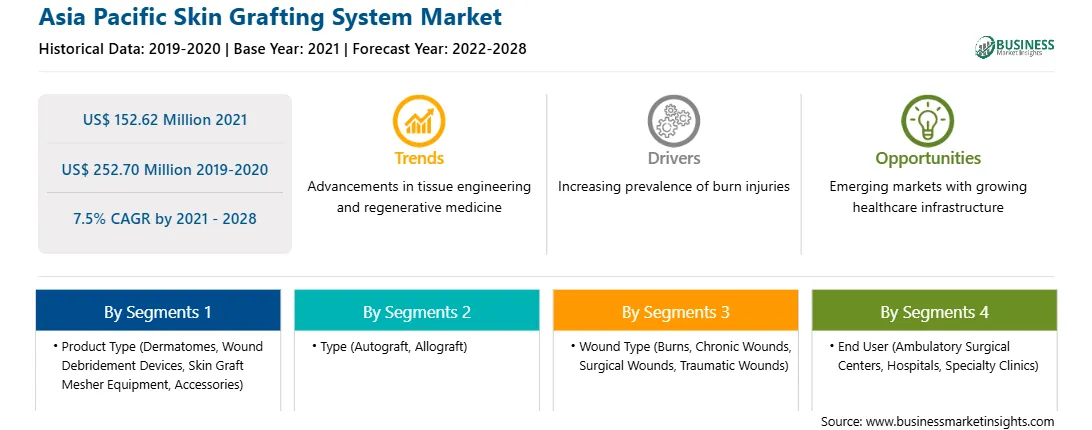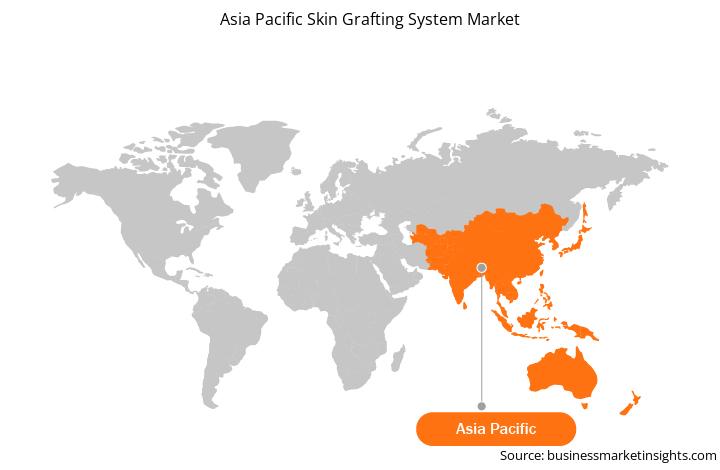Skin grafting systems can use skin grafts from a variety of sources. Apart from the autograph, artificial and 3D printed skin grafts gained popularity due to their advantages. For instance, a few examples of substitutes for skin grafts are genetically modified pigskin, CelluTome Epidermal Harvesting System, and Xpansion Microautografting System. In recent years, physicians and surgeons at Massachusetts General Hospital have begun experimenting with the use of skin grafts from genetically modified pigs. As per the hospital’s own data, doctors could use the grafts for twice the time of normal procedures. Also, the team found that the genetically modified grafts developed a vascular system within just four days. Xpansion Microautografting System is preferred in case of severe burns when it is not possible to get a donor. This device can expand traditional split-thickness skin grafts up to nine times their original length. This helps the physician cover more of the wound with less initial donor skin, without any increased risk of infections or other side effects. In 2013, Kinetic Concepts Inc. launched CelluTome Epidermal Harvesting System, which allows clinicians and other medical personnel to harvest healthy epidermal skin tissue without damaging the donor site.
Since the development of alternatives to skin grafts, various companies have commercialized their products as alternatives to skin grafts. One of the skin graft alternatives is DermaClose by SYNOVIS Micro Companies Alliance, Inc., a subsidiary of Baxter International Inc. After 2016, DermaClose was commercially launched in the markets; it is a continuous external tissue expander that enables rapid tissue movement to reduce wounds. DermaClose is intended to heal wounds such as scalp, trauma, sternal, abdominal, fasciotomy, diabetic wounds, and flap donor sites. DermaClose heals wounds in reduced time with no requirement of re-adjustment of device.
Similarly, in July 2020, Merakris Therapeutics, LLC. commercialized an alternative to skin-graft to help protect and heal wounds. Leakris Therapeutics, LLC named its product as Dermacyte Matrix, a crosslinked amniotic membrane allograft. Dermacyte Matrix is designed for cutaneous wound applications, generally for outpatient, surgical, and dermatology clinics.
Thus, these alternative sources of skin grafts further aid in the growth of skin grafting practices and procedures, thereby driving the growth of the skin grafting system market.
With the new features and technologies, vendors can attract new customers and expand their footprints in emerging markets. This factor is likely to drive the APAC skin grafting system market in the coming years. The market is expected to grow at a good CAGR during the forecast period.
Strategic insights for the Asia Pacific Skin Grafting System provides data-driven analysis of the industry landscape, including current trends, key players, and regional nuances. These insights offer actionable recommendations, enabling readers to differentiate themselves from competitors by identifying untapped segments or developing unique value propositions. Leveraging data analytics, these insights help industry players anticipate the market shifts, whether investors, manufacturers, or other stakeholders. A future-oriented perspective is essential, helping stakeholders anticipate market shifts and position themselves for long-term success in this dynamic region. Ultimately, effective strategic insights empower readers to make informed decisions that drive profitability and achieve their business objectives within the market.

| Report Attribute | Details |
|---|---|
| Market size in 2021 | US$ 152.62 Million |
| Market Size by 2028 | US$ 252.70 Million |
| Global CAGR (2021 - 2028) | 7.5% |
| Historical Data | 2019-2020 |
| Forecast period | 2022-2028 |
| Segments Covered |
By Product Type
|
| Regions and Countries Covered | Asia-Pacific
|
| Market leaders and key company profiles |
The geographic scope of the Asia Pacific Skin Grafting System refers to the specific areas in which a business operates and competes. Understanding local distinctions, such as diverse consumer preferences (e.g., demand for specific plug types or battery backup durations), varying economic conditions, and regulatory environments, is crucial for tailoring strategies to specific markets. Businesses can expand their reach by identifying underserved areas or adapting their offerings to meet local demands. A clear market focus allows for more effective resource allocation, targeted marketing campaigns, and better positioning against local competitors, ultimately driving growth in those targeted areas.

APAC Skin Grafting System Market Segmentation
The APAC skin grafting system market is segmented on the basis of product type, type, wound type, end user, and country. The market, based on product type, is segmented into dermatomes, wound debridement devices, skin graft mesher equipment and accessories, and others. The wound debridement devices segment held the largest share of the market in 2021. Based on type, the APAC skin grafting system market is bifurcated into autograft and allograft. The autograft segment held a larger share of the market in 2021 and is expected to hold a significant share of the market during the forecast period. Based on wound type, the market is segmented into burns, chronic wounds, traumatic wounds, surgical wounds, and others. The burns segment is expected to hold the largest market share during the forecast period. Based on end user, the APAC skin grafting system market is segmented into hospitals, ambulatory surgical centers, and specialty clinics. The hospitals segment held the largest share of the market and is expected to register the highest CAGR during the forecast period. Based on country, the APAC skin grafting system market is segmented into Australia, China, India, Japan, South Korea, and the Rest of APAC.
Aygun Surgical Instruments Co., Inc.; De Soutter Medical; Humeca BV; Integra Lifesciences Holdings Corp.; Lutz GmbH & Co. KG; Smith & Nephew; Stryker Corp.; and Zimmer Biomet are among the leading companies in the APAC skin grafting system market.
The Asia Pacific Skin Grafting System Market is valued at US$ 152.62 Million in 2021, it is projected to reach US$ 252.70 Million by 2028.
As per our report Asia Pacific Skin Grafting System Market, the market size is valued at US$ 152.62 Million in 2021, projecting it to reach US$ 252.70 Million by 2028. This translates to a CAGR of approximately 7.5% during the forecast period.
The Asia Pacific Skin Grafting System Market report typically cover these key segments-
The historic period, base year, and forecast period can vary slightly depending on the specific market research report. However, for the Asia Pacific Skin Grafting System Market report:
The Asia Pacific Skin Grafting System Market is populated by several key players, each contributing to its growth and innovation. Some of the major players include:
The Asia Pacific Skin Grafting System Market report is valuable for diverse stakeholders, including:
Essentially, anyone involved in or considering involvement in the Asia Pacific Skin Grafting System Market value chain can benefit from the information contained in a comprehensive market report.